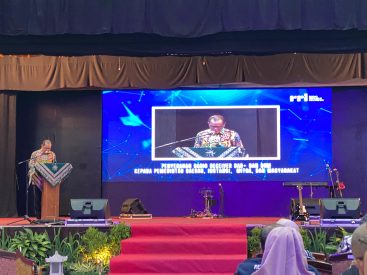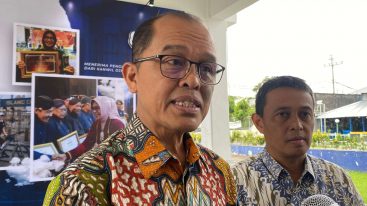In order to expand broadcast coverage, improve access to information services, and support disaster warning needs, the regional office of the Indonesian national broadcaster, Radio Republik Indonesia (RRI) in Yogyakarta, (Yogyakarta is a major tourist destination, known for its cultural significance and role as a centre for arts and culture of Java), distributed, free of charge, 148 receivers to the Regional Government, other RRI partners, and loyal listeners. Some were Digital Radio Mondiale (DRM) radios, others were Digital Audio Broadcasting (DAB+) receivers. The 148 units were handed over by the RRI Director of Technology and New Media, Muhamad Sujai, and the Member of the Supervisory Board of RRI, Enderiman Butar Butar. During his presentation at the RRI Yogyakarta Auditorium at the end of May Mr Sujai mentioned several advantages of digital radio, including the ability to carry more radio programmes than in analogue on a single frequency and with clearer audio output.
Digital radio is already present in several Indonesian regions. “For DRM, we’re operating in Gunung Sitoli, Bengkulu, and Yogyakarta,” the TMB Director stated.
One of DRM’s advantages, according to Sujai, is its built-in Emergency Warning Functionality (EWF). This system can interrupt ongoing digital broadcasts to deliver emergency notifications when a disaster occurs. When EWF is activated, the regular programme will be temporarily interrupted.
“For example, if Mount Merapi erupts, the designated channel will override all ongoing programmes – just with the press of a button. It has to be in collaboration with the regional disaster management agency (BPBD), so perhaps we can coordinate on this in the future,” he said.
The importance of using DRM digital radio for saving lives was a major point of the presentation, as Yogyakarta itself is in a well-known disaster-prone area. The Regional Secretary (Sekda) of DIY, Beny Suharsono, emphasized the need for co-operation between various parties and RRI going forward. “This is the most concrete step we can take so that when people hear RRI, they don’t only think of everyday information, but also of extraordinary, life-saving information,” he said.
This way, EWF broadcasts, that override other programming, won’t cause issues in the future. “We must involve the Meteorological Agency (BMKG) and all relevant stakeholders to prevent confusion. Emergency information must be treated with authority and not be taken lightly. The operators must truly understand the EWF conditions,” Beny said. The digital DRM radio system could be integrated with ongoing disaster mitigation programmes in Yogyakarta, such as the Satlinmas rescue teams, he added.
The Head of RRI Yogyakarta, Arlin Setyaningsih, stated that her station already operates a DRM transmitter with EWF functionality in Kaliurang. “The existing transmitters and receivers can really be used optimally by the public as indicators when a disaster occurs,” she said. “The purpose of providing digital radios is to promote the concept of digital radio, which is already operational here in Yogyakarta. After receiving your radio, please try it out and compare it to analogue – you’ll notice the sound from digital radio is much clearer,” said Arlin. She hopes that the digital radios distributed this time will be used to their full potential by the public. Besides enjoying clearer radio broadcasts, these digital radios are also expected to help educate the public about disaster preparedness and early warning systems.
As the main promoter of the event, the RRI Director of Technology and New Media, Muhamad Sujai, expressed hope that more people will adopt digital radio in the future, emphasizing that the sound quality is significantly better and clearer than analogue radio. “In the future, digital radio will be implemented in major cities to increase efficiency and effectiveness. It saves energy, especially electricity,” he concluded.
The distribution of the 148 receivers happened in parallel with a recent digital-analogue radio trial in Yogyakarta. A multi-standard receiver module (DRM, DAB and analogue), developed by the two DRM Consortium members, RF2Digital and Elements Innovation, delivered excellent results in the city. The Indonesian specialists who carried out the trial concluded in their final report that: “throughout the testing process, the prototype consistently captured signals with stability and delivered clear audio quality without any technical issues or operational difficulties.”
This DRM-DAB module, the first of its kind in the world is the obvious solution for the future. It offers the way to manufacture composite DRM-DAB receivers that can be commercialised in Indonesia and other parts of the world adopting both DRM and DAB and looking for one complete receiver for broadcasts in DRM, DAB and analogue.
Digital radio is already present in several Indonesian regions. “For DRM, we’re operating in Gunung Sitoli, Bengkulu, and Yogyakarta,” the TMB Director stated.
One of DRM’s advantages, according to Sujai, is its built-in Emergency Warning Functionality (EWF). This system can interrupt ongoing digital broadcasts to deliver emergency notifications when a disaster occurs. When EWF is activated, the regular programme will be temporarily interrupted.
“For example, if Mount Merapi erupts, the designated channel will override all ongoing programmes – just with the press of a button. It has to be in collaboration with the regional disaster management agency (BPBD), so perhaps we can coordinate on this in the future,” he said.
The importance of using DRM digital radio for saving lives was a major point of the presentation, as Yogyakarta itself is in a well-known disaster-prone area. The Regional Secretary (Sekda) of DIY, Beny Suharsono, emphasized the need for co-operation between various parties and RRI going forward. “This is the most concrete step we can take so that when people hear RRI, they don’t only think of everyday information, but also of extraordinary, life-saving information,” he said.
This way, EWF broadcasts, that override other programming, won’t cause issues in the future. “We must involve the Meteorological Agency (BMKG) and all relevant stakeholders to prevent confusion. Emergency information must be treated with authority and not be taken lightly. The operators must truly understand the EWF conditions,” Beny said. The digital DRM radio system could be integrated with ongoing disaster mitigation programmes in Yogyakarta, such as the Satlinmas rescue teams, he added.
The Head of RRI Yogyakarta, Arlin Setyaningsih, stated that her station already operates a DRM transmitter with EWF functionality in Kaliurang. “The existing transmitters and receivers can really be used optimally by the public as indicators when a disaster occurs,” she said. “The purpose of providing digital radios is to promote the concept of digital radio, which is already operational here in Yogyakarta. After receiving your radio, please try it out and compare it to analogue – you’ll notice the sound from digital radio is much clearer,” said Arlin. She hopes that the digital radios distributed this time will be used to their full potential by the public. Besides enjoying clearer radio broadcasts, these digital radios are also expected to help educate the public about disaster preparedness and early warning systems.
As the main promoter of the event, the RRI Director of Technology and New Media, Muhamad Sujai, expressed hope that more people will adopt digital radio in the future, emphasizing that the sound quality is significantly better and clearer than analogue radio. “In the future, digital radio will be implemented in major cities to increase efficiency and effectiveness. It saves energy, especially electricity,” he concluded.
The distribution of the 148 receivers happened in parallel with a recent digital-analogue radio trial in Yogyakarta. A multi-standard receiver module (DRM, DAB and analogue), developed by the two DRM Consortium members, RF2Digital and Elements Innovation, delivered excellent results in the city. The Indonesian specialists who carried out the trial concluded in their final report that: “throughout the testing process, the prototype consistently captured signals with stability and delivered clear audio quality without any technical issues or operational difficulties.”
This DRM-DAB module, the first of its kind in the world is the obvious solution for the future. It offers the way to manufacture composite DRM-DAB receivers that can be commercialised in Indonesia and other parts of the world adopting both DRM and DAB and looking for one complete receiver for broadcasts in DRM, DAB and analogue.




